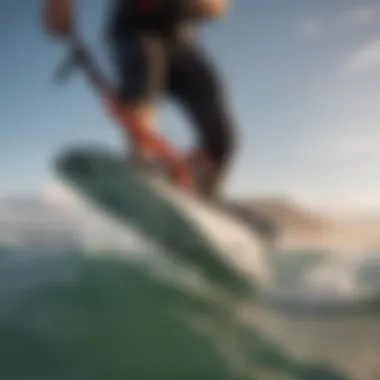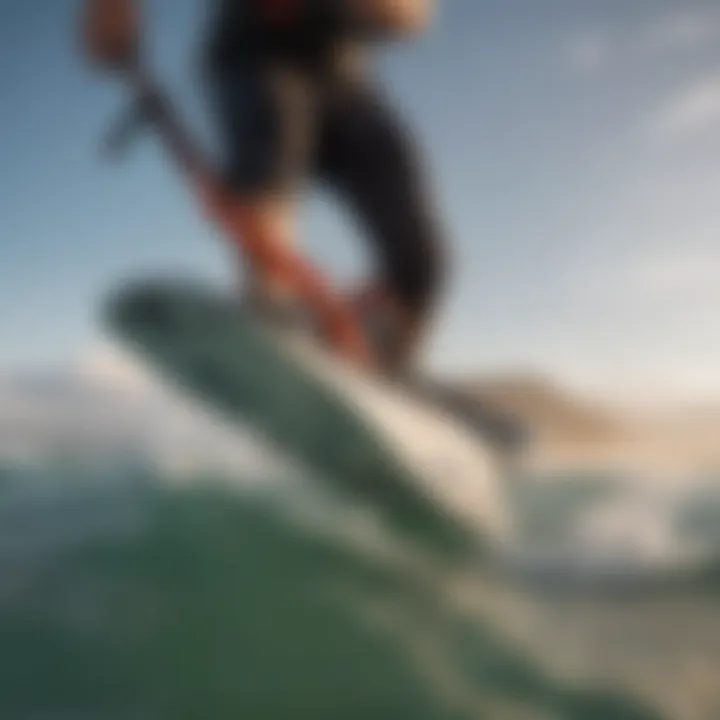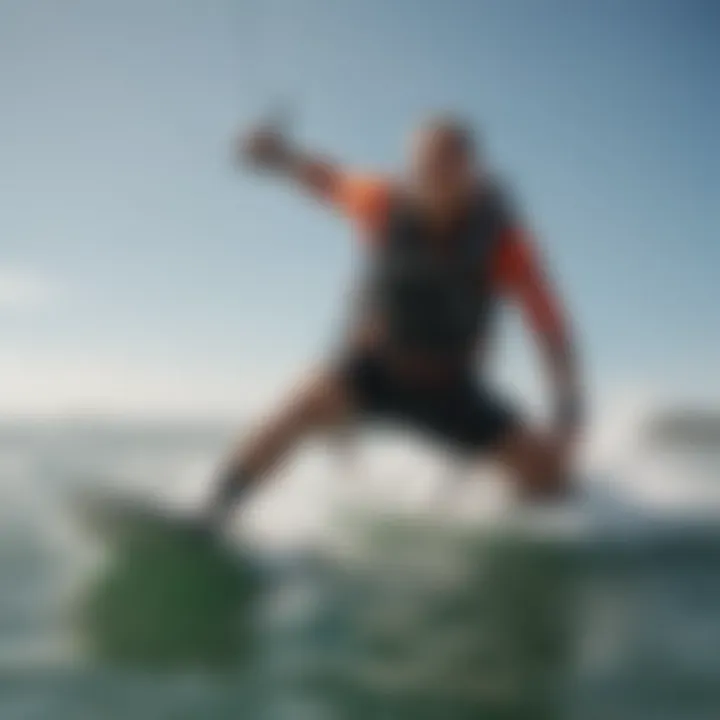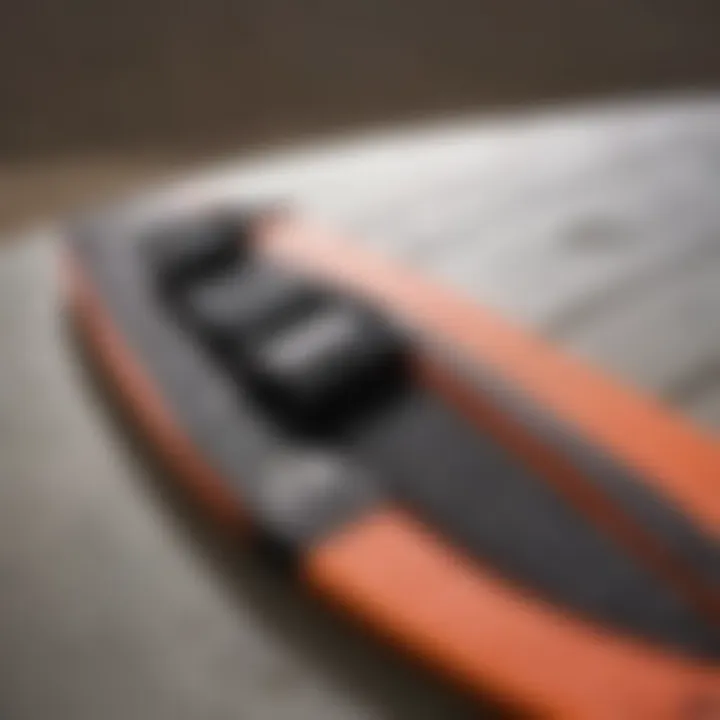The Crucial Role of Surfing Straps in Kitesurfing


Intro
Kitesurfing and kiteboarding are exhilarating sports that blend the thrill of surfing with the challenge of flying a kite. Among the various components that make these activities enjoyable, surfing straps play a critical role. These straps hold the rider's feet securely to the board, providing essential control and stability during maneuvers. Without the right straps, even the most skilled kiteboarder might struggle to execute a jump or navigate challenging conditions.
In this article, we will dig into the significance of surfing straps. We'll take a look at the different types of straps available on the market, the materials used to make them, and how they affect comfort and safety. Additionally, we will discuss how to select the right straps for your style and riding conditions, and the importance of maintenance.
Equipment Reviews
Before diving deep into the specifics of surfing straps, it helps to frame them within the wider context of kitesurfing gear. The gear you choose, including kites, boards, and accessories, all work in tandem to elevate your experience out on the water.
Kites
When it comes to kites, you have a smorgasbord of options all designed for different riding styles and wind conditions. Today’s kites come in various shapes — bow, delta, and C-kites, to name a few. Each shape affects how the kite behaves in the air and consequently impacts your riding experience. For instance, bow kites generate greater power at lower wind speeds, making them ideal for beginners, while C-kites offer advanced control for seasoned pros.
Key kite brands and models include:
- Naish Pivot: Great for all-around performance.
- Duotone Rebel: Ideal for freestyle riders.
- Ozone Edge: Perfect for speed and power in strong winds.
Boards
The choice in kiteboarding boards is equally vast. Riders can select between twintip boards, which are symmetrical and great for tricks, or directional boards, which excel in wave riding. Different designs cater to different conditions, too. A board's construction materials can add to its durability and weight. Look for lightweight carbon fiber boards if speed is your game or opt for heavier boards for stability in challenging waves.
Accessories
Besides kites and boards, accessories constitute an essential part of your setup. Items like harnesses, lines, and safety gear ensure a safer ride while enhancing performance.
- Harnesses: Secure your body to the kite, distributing the pull across your body.
- Lines: Their material and length affect responsiveness and overall performance.
- Safety Gear: Helmets, impact vests, and quick-release mechanisms can mean the difference between a fun day out and a trip to the emergency room.
Culmination
Having the right surfing straps is just one piece of the puzzle in kitesurfing and kiteboarding. This article aims to illuminate their essential role while exploring how they mesh with the equipment and conditions riders encounter. By understanding the nuances of equipment, kitesurfers can maximize their enjoyment and safety on the water, regardless of their skill level.
Understanding the Importance of Surfing Straps
Surfing straps play a pivotal role in both kitesurfing and kiteboarding, serving as the essential link between the rider and their equipment. When one hits the waves or glides across the water, having reliable and efficient straps can significantly alter the experience, influencing not just comfort but also performance, safety, and control. In this section, we will discuss the importance of these straps in depth, particularly focusing on their definition, purpose, and the numerous benefits they provide to riders of all skill levels.
Definition and Purpose
At its core, a surfing strap is a piece of equipment designed to keep a rider securely connected to their board, whether in kitesurfing or kiteboarding. Think of it as the safety net that holds everything together while giving one the freedom to maneuver through the water, tackle waves, or enjoy a glide under the open sky.
The primary purpose of these straps is to provide a stable and secure attachment point. Without them, riders may struggle to maintain balance and control, especially in challenging conditions. A well-designed surfing strap caters to the specific needs of the rider, ensuring they can easily engage with their board while maintaining the necessary mobility to execute tricks or navigate through turbulent waters.
In addition, surfing straps help maintain a connection that ensures proper weight distribution across the board, enhancing performance. When the straps fit correctly, they allow the rider to transfer their energy efficiently through the board, which is crucial during sudden movements or when catching air.
Connecting Rider to Equipment
Beyond just keeping the rider attached, surfing straps are integral in creating a harmonious relationship between person and board. This connection essentially transforms the rider into an extension of the equipment, enabling a more fluid interaction with the water. The straps facilitate this by allowing immediate responsiveness to the rider's body movements. For example, when a rider leans to turn or shifts their weight to activate a jump, the straps should work in synergy with those movements, providing both flexibility and stability.
"Good straps can make the difference between a seamless ride and a jarring experience on the water."
Moreover, the right straps can drastically reduce fatigue during extended sessions. When they secure the rider's feet and ankles properly, they prevent unnecessary slip and strain, letting athleticism shine through without causing discomfort. Comfort plays a key role in performance, and having that ease of movement can allow for longer, more enjoyable rides.
In summary, surfing straps are way more than an accessory; they are a fundamental component in kitesurfing and kiteboarding. By understanding their definition and purpose, as well as how they connect the rider to their equipment, one can appreciate the critical role they fulfill in enhancing the overall kitesurfing experience. As we dive deeper into specific types of surfing straps in the upcoming sections, keeping the significance of these connections in mind will help host a greater respect for the equipment that supports every ride.
Types of Surfing Straps
Understanding the different kinds of surfing straps is crucial for kitesurfers and kiteboarders. The way a rider connects with their equipment can greatly affect performance, comfort, and safety on the water. When you think about it, varying strap types each come with their unique advantages tailored for specific riding styles and conditions. From foot straps that offer a solid grip during high jumps to wrist straps that provide added security when navigating wild waves, the right choice can enhance your experience in surprising ways.
Foot Straps
Foot straps are a staple in kitesurfing and kiteboarding. They are directly attached to the board, allowing the rider to secure their foot for optimal control. Properly fitted foot straps can truly make or break a ride. When executed well, these straps help maintain stability while executing maneuvers, especially when you’re catching some serious air.
The design of foot straps can vary widely, from basic versions to highly customizable setups that cater to advanced riders. Foot straps typically come with padding for comfort, and often are equipped with adjustable features to accommodate diverse foot sizes. Riders often find that a snug fit increases confidence, reducing the risk of slipping out during intense sessions.
Wrist Straps
Wrist straps are primarily used for safety, connecting the rider to their kite. Imagine being out in the water when things go wrong; that's where wrist straps shine. They ensure that if a kiteboarder loses their grip on the control bar, the kite will still remain tethered. Safety in kitesurfing cannot be taken lightly, so choosing the right wrist strap is vital.
Wrist straps are often designed with comfort and adjustability in mind. They should fit snugly yet allow for quick release during emergency situations. A poorly designed strap can lead to unintentional detachment, which can be hazardous. Regular users note that well-constructed wrist straps can make a huge difference in overall control and peace of mind while riding.
Ankle Straps
Ankle straps, while not as commonly discussed, play an important role in the kitesurfing and kiteboarding setup. These straps are designed for those who prefer a more secure attachment to their boards, especially in rough water conditions. Ankle straps can help prevent the board from pulling away during wipeouts or if your feet slip out of the foot straps.
The construction of ankle straps is crucial; they often feature materials that provide both durability and flexibility. Comfort is another important factor. Straps that dig into your skin or restrict movement can ruin a session. Finding the right fit is essential, and there are adjustable options available that cater to a wide range of preferences.
Overall, foot, wrist, and ankle straps each have a distinct purpose in kitesurfing and kiteboarding. A keen understanding of their differences—and selecting the right one for your needs—can lead to a more secure, comfortable, and ultimately exhilarating experience on the water.
Materials in Surfing Straps
When it comes to the world of kitesurfing and kiteboarding, the materials that make up surfing straps can’t be overlooked. They are not just simple accessories; they contribute significantly to overall performance, safety, and comfort for the rider. By selecting the appropriate materials for these straps, a kitesurfer can influence their experience on the water profoundly. This section dives into the specifics of the materials, highlighting the advantages, adjustable features, and durability aspects that make surfing straps essential equipment.
Neoprene Advantages
Neoprene stands out as a primary material for surfing straps, owing to its unique properties. One of the most noteworthy advantages is its flexibility. This rubber-like material provides a snug fit that adapts to the shape of the foot or ankle, delivering a comfortable hold during rides.


Moreover, neoprene has excellent water-resistant qualities. When you’re out on the water, the last thing you want is for your straps to absorb water and become heavy. Neoprene helps with this, allowing for a lightweight feel that doesn’t weigh you down while also providing some insulation against the cold – this is especially critical during those early morning sessions when the water temperature can be a bit nippy.
Also, production of neoprene straps often involves some level of padding. This adds an extra layer of comfort that cushions the rider's feet, preventing any harsh chafing during long hours out on the board.
Adjustable Straps
The adjustability of surfing straps is another fundamental aspect that enhances their performance. Riders come in all shapes and sizes, so having the option to adjust the strap settings is vital for achieving the perfect fit. Many brands now implement fasteners and buckles that allow the wearer to make quick adjustments, even while on the move.
With customizable placements, surfers can find the sweet spot that suits their individual riding style. Whether it’s a tighter grip for freestyle maneuvers or a looser fit for wave riding, adjustable straps cater to diverse needs. This adaptability is critical, as it can impact the rider's overall control and balance on the board.
Durability Factors
When choosing surfing straps, considering durability is crucial. Straps are subject to wear and tear due to continual exposure to saltwater, sunlight, and rough handling. Materials must withstand such demands without losing their integrity.
High-quality nylon and reinforced stitching often complement neoprene to enhance the lifespan of these straps. The stitching, especially, plays a pivotal role – if it fails, the entire strap’s usability diminishes. Riders should also pay attention to the thickness of the material, as thicker straps tend to provide better durability, though this can slightly affect flexibility.
Additionally, some brands coat their straps with UV-resistant materials to prevent degradation from sun exposure. Keeping the longevity in mind will not just save money; it contributes to safety since frayed or worn straps can lead to accidents.
Understanding the materials used in surfing straps is foundational for anyone serious about kitesurfing or kiteboarding. High-performance materials lead to better experiences on the water, paving the way for thrilling adventures and enduring sessions under the sun.
Comfort and Fit
When it comes to kitesurfing and kiteboarding, the little things go a long way. Among these, comfort and fit of surfing straps are crucial for having a smooth ride. Good straps can make a world of difference by ensuring the rider feels secure, connected, and comfortable throughout the adventure on the water.
Finding the Right Size
Finding the right size is essential. Just like trying on shoes, straps shouldn’t be too tight or too loose. If they’re snug, they will give you the support you need when you take off. However, if they are overly tight, it could lead to discomfort and even restrict your movements. Straps that are too loose can lead to slippage, compromising your control on the board. To make sure you have the right size, it’s smart to measure your foot or ankle before making a purchase. Meanwhile, trying them on with a wetsuit can also help you understand how they fit in real-world conditions.
In fact, here's what to keep in mind while sizing:
- Measure your foot's length and width.
- Consider the thickness of any wetsuit you may wear.
- Check the manufacturer’s size chart for each strap model, as sizes can differ between brands.
Customizable Options
Customizable options are where the game changes completely for the kitesurfer. Many brands now offer straps with features designed to be adjusted to meet your needs. This can involve everything from adjustable lengths to additional padding or custom artwork.
The beauty of customization is that it allows you to tweak your gear for a perfect fit. For instance, some straps come with extra cushioning to relieve pressure points, ideal for those marathon sessions on the water. Others might include quick-release buckles that allow you to ease out in an instant during those tricky maneuvers.
Some options worth considering include:
- Adjustable Lengths: Tailor the fit to how you ride.
- Memory Foam Padding: Provides additional comfort.
- Velcro or Buckle Systems: Easy to open and adjust.
Ultimately, taking the time to find the right fit and explore customizable features enhances not only your enjoyment but also your performance on the water.
"Well-fitting straps become like a second skin, allowing you to fully engage with your board without distractions."
Kitesurfing and kiteboarding should feel liberating, and with the right straps, every twist and turn becomes effortless.
Safety Considerations
In the world of kitesurfing and kiteboarding, safety isn't just a nice-to-have; it�’s an absolute must. Surfing straps play a significant role in keeping riders connected to their equipment, ensuring both performance and security while out on the water. The right strap system can greatly enhance a rider's ability to respond to sudden changes in conditions, and most importantly, can be the difference between a thrilling ride and a dangerous situation.
Strap Release Mechanisms
One crucial aspect of surfing straps is their release mechanisms. These devices are designed to allow a rider to detach quickly from their board in emergencies. Let's take a look at how they work and why they’re vital:
- Quick-release buckles: These are often strategically placed to ensure they can be easily reached even during a tumble. Riders should practice using these mechanisms before hitting the waves.
- Safety leashes: Some setups incorporate safety leashes that prevent complete detachment but allow the rider to escape the board. This can be crucial in scenarios where the board might pose a hazard.
- User customization: Riders may find varied mechanisms that tailor to their skill level and personal comfort, creating a sense of confidence when out on the water.
In essence, strap release mechanisms are not to be overlooked. They can mean speedier reaction times and a higher chance of safety when conditions turn tough. Riders who overlook this aspect may find themselves in sticky situations, quite literally.
Emergency Detachment
Tying into the previous point, the ability to detach from your board instantly during emergencies cannot be emphasized enough. Riders need to be ready for everything from unexpected gusts to sudden changes in tide. Here are some points to consider regarding emergency detachment:
- Training: Before hitting the water, it’s wise to practice how to use the emergency release system. Familiarity with the process can save precious seconds in a crisis.
- Regular Inspections: Before each session, inspect straps and release mechanisms for wear and tear. A worn strap might not perform as expected, risking safety.
- Situational Awareness: Riders should always be aware of their environment. Knowing when conditions are becoming too risky helps in deciding whether to detach or stay strapped in.
"In high-risk sports like kitesurfing, preparation is your best friend. Knowing your gear can keep you safer than any life jacket ever could."
Riders should take these factors to heart. Recognizing the significance of strap release mechanisms and the need for emergency detachment is half the battle won for ensuring a safe and enjoyable kitesurfing experience. Safety should never be an afterthought; it needs to be front and center in a kitesurfer's mind.
Performance Impact of Surfing Straps
Understanding the performance impact of surfing straps in kitesurfing and kiteboarding is crucial for any rider who aims for peak efficiency and enjoyment in their sessions. These straps are not just accessories; they directly influence various aspects of riding, shaping the way one interacts with the board and the kite.
Stability Enhancement
When you’re carving through waves or cutting across flat water, stability becomes an anchor point. The right surfing straps enhance the rider's stance, providing more grip and reducing unwanted slip. This stability can be particularly vital when navigating challenging conditions, where shifting winds and unpredictable water can lead to a chaotic experience. Better strap design allows a rider to feel grounded, making it easier to execute tricks or maintain balance during high-speed maneuvers.
A few points to keep in mind about stability include:
- Foot Positioning: Straps should hold the feet securely without causing discomfort. This can help in achieving better foot placement on the board, thereby influencing overall control.
- Wider Strap Base: A strap that has a broader platform distributes the force evenly across your feet, giving you more stability as you ride.
- Material: The composition of the straps affects their stiffness and responsiveness. Soft, cushioned straps absorb shocks, whereas stiffer options may enhance feedback from the board.
For many riders, the balance between comfort and control plays a tremendous role. The straps can make a significant impact on how feedback from the board translates into ride performance. Ultimately, investing time in choosing the right straps can lead to noticeable improvement in handling and stability, especially when riding in conditions that demand more from the equipment.
Control Dynamics
Control is where a rider truly feels the synergy between themselves, the board, and the kite. The dynamics of control are deeply intertwined with how firmly a rider is attached to their board through the surfing straps. Properly adjusted straps allow a rider to assert their will over turns, jumps, and other maneuvers with confidence.


Crucial factors to consider include:
- Strap Tension: Well-adjusted tension in the straps allows for quick response during maneuvers. Too loose, and you risk losing connection; too tight, and you might find yourself limited in mobility.
- Angle of Positioning: Straps positioned wrong can not only make riding uncomfortable but also affect the ability to effectively control the board. A slight angle can dramatically change performance when it comes to initiating turns or sliding.
- Feedback Mechanism: Equipped with the right straps, every subtle input from the rider translates into a change in movement, whether it be a shift in weight to make a turn or a motion to jump.
"Straps are like the invisible thread connecting you to your ride; they make the difference between gliding effortlessly or feeling like you're just along for the ride."
Introducing better control dynamics leads to increased confidence. With confidence, riders will push their boundaries, try new tricks, and explore different styles and environments. The overall experience is harmonized when you can control your ride more effectively, and thus, becoming an extension of the board itself.
In summary, the performance impact of surfing straps significantly enriches a kitesurfer’s or kiteboarder’s experience. Straps providing stability and control enable riders to perform at their optimal potential, making each session not only a test of skill but also a celebration of fluid movement over the water.
Adjustments and Personalization
When it comes to kitesurfing and kiteboarding, the fit of your gear can be the make-or-break factor during your sessions on the water. Adjustments and personalization of surfing straps play an essential role in how well a rider can control their board, maintain balance, and ultimately enjoy the experience. Everything from foot position to strap tension can be tailored to a rider's preferences, allowing you to maximize performance while minimizing discomfort. These adjustments are not merely about comfort but also about achieving the right synergy between rider and equipment, which is necessary for navigating varying conditions.
Fine-tuning Straps for Individual Needs
Every kitesurfer is different, and this variance in anatomy and riding style makes fine-tuning your straps particularly important. Straps that fit snugly yet comfortably can enhance your riding experience significantly, allowing you to focus on technique rather than the nagging discomfort that comes from poorly fitted gear.
- Foot Positioning: Proper placement of the foot straps can influence control. Riders often experiment with the distance between their feet, as this can affect how easily one can shift weight during maneuvers.
- Tension Levels: Adjusting the tightness of the straps according to personal comfort is crucial. If too tight, they can lead to cramping or restrict movement; too loose, and you may feel insecure. Finding the middle ground is key.
- Experimentation: Many experienced riders recommend regularly assessing your strap settings, especially after a change in gear or riding conditions. Doing so allows for continued optimization based on evolving techniques or personal changes.
"The closer you can get your setup to your personal preference, the more you'll enjoy your time on the water. It's all about turning theory into practice and finding that sweet spot."
Methods of Adjustment
Adjustments can be made in a variety of ways, and knowing how to effectively implement these changes is essential for a tailored riding experience. Here are some widely utilized methods:
- Strap Placement: Typical designs allow for horizontal or vertical adjustments, making it easy to reposition the foot straps.
- Length Adjustments: Many straps come with different length settings. Simply increasing or decreasing the strap length can impact how snugly you secure your feet.
- Testing Gear Longevity: Check for wear and tear over time. A frayed strap can lead to unpredictable behavior on the board, so replacement should be part of your regular gear maintenance routine.
- Moving them closer together may benefit those with a more athletic stance, while wider placements can enhance stability for beginners.
- Utilize the Velcro or buckle systems for precise management.
- Consider keeping a spare set of straps handy to cover different riding conditions or preferences.
Understanding these adjustments not only elevates individual performance but is also a foundational aspect of a successful kitesurfing journey. Your choice of straps serves as an extension of your riding style, so maximizing their potential is the name of the game.
Caring for and Maintaining Straps
Caring for surfing straps in kitesurfing and kiteboarding isn't just about prolonging their lifespan; it's about ensuring safety and performance on the water. Proper maintenance can make a world of difference in how straps function, which can directly affect control during rides. The importance of this topic cannot be overstated; well-cared-for straps lead to optimal performance.
When it comes to this equipment, a little attention can save a lot of trouble down the line. Failing to keep straps clean and stored properly can lead to degradation of materials and potentially risky malfunctions. Straps that are in good shape offer better grip and support, allowing riders to fully unleash their potential.
Cleaning Techniques
Keeping surfing straps clean involves more than just a casual rinse; it's an integral part of maintenance that is often overlooked. Here are some key cleaning techniques to consider:
- Rinse After Use: Immediately after coming back from the water, rinse your straps with fresh water. Salt and sand can corrode materials if left to dry on the strap. This small effort can extend the life of your equipment significantly.
- Use Mild Detergents: If your straps are particularly dirty, consider a mild soap solution. Avoid harsh chemicals as they can break down the materials over time.
- Soft Brushes and Cloths: Utilize a soft brush to scrub away any stubborn grime. A damp cloth is also effective for wiping down the straps. Just be gentle; you don’t want to damage the material.
- Dry Properly: After cleaning, let your straps air dry. Avoid direct sunlight for extended periods, as it can fade colors and weaken materials.
These techniques are not mere suggestions but rather best practices that aid in the longevity of your straps and enhance their effectiveness when you need them the most.
Storage Recommendations
How you store your surfing straps can be just as important as how you clean them. Proper storage helps prevent wear and tear, ensuring that the straps remain ready for action when the time comes. Here are some thoughtful storage recommendations:
- Avoid Tension: Don't leave your straps under tension for prolonged periods. Hanging them loosely can prevent deformities that might hinder performance.
- Cool, Dry Place: Store your straps in a cool, dry place away from intense sunlight. Excessive heat can cause materials to degrade faster.
- Protect from Sharp Objects: Ensure that your straps are stored away from sharp objects or unnecessary clutter that could scrape or puncture them.
- Regular Checks: Periodically examine your straps for signs of wear, fraying, or damage. Catching these issues early can be a game-changer when it comes to performance and safety.
By following these cleaning and storage guidelines, you are not only prolonging the life of your surfing straps but also making an investment in your overall kitesurfing experience. Keeping gear in top shape aids in performance, safety, and ultimately, enjoyment out on the waves.
Choosing the Right Straps for Different Conditions
Selecting the appropriate surfing straps for kitesurfing and kiteboarding isn't just a matter of preference; it's crucial for enhancing performance and ensuring safety. Different conditions can drastically affect how straps should perform, impacting a rider's overall experience. Understandably, a seasoned kiter should pay attention to these factors to fully enjoy their session. Here are several key points to consider when choosing the right straps based on varying conditions.
Flat Water vs. Wave Riding
When riding on flat water, the primary focus tends to be on speed and control. Straps designed for this environment typically offer a snug fit without excessive padding. This allows for a more direct connection to the board. An ideal choice is a strap with less foam and a minimalist design; it promotes agility and responsiveness, giving riders that much-needed edge when trying to carve or jump. Conversely, wave riding demands a different approach. During intense maneuvers, the variability of waves can throw a rider off balance. It’s wise to opt for straps that feature more cushioning and a wider surface area. This added support helps in maintaining stability while navigating through the surf. In summary:
- Flat Water: Seek thinner, more responsive straps for direct board feel.
- Wave Riding: A thicker, padded strap can cushion impacts and support stability.
"Choosing the right strap for the type of water can be the difference between a smooth ride and a jarring experience."
Light Wind vs. High Wind Settings
The wind conditions you face should also tailor your strap selection. In light wind conditions, there's often a need for maximum efficiency in connecting your movements to the kite and board. Lightweight straps with adjustable features can be beneficial; they allow for easy modifications to improve performance. These conditions reward finesse, so a strap that doesn’t restrict movement is critical.
On the other hand, in high wind settings, the stakes are elevated. The potential for more aggressive maneuvers, coupled with greater forces acting on you, means that your choice of strap becomes more significant than ever. In these scenarios, it’s advisable to go for robust straps with superior grip and a secure locking mechanism. A veritable battle against the elements can ensue, and ensuring that you remain attached firmly to your board becomes paramount.
To recap:
- Light Wind: Employ lightweight, easy-to-adjust straps to maximize efficiency.
- High Wind: Use secure, sturdy straps that provide grip and stability.
In essence, understanding the unique requirements of both water conditions and wind strength is essential in the art of kitesurfing and kiteboarding. Making informed choices about strap type can greatly enhance your performance and ensure your time on the water is both enjoyable and secure.
Straps and Riding Styles
Straps play a critical role in the world of kitesurfing and kiteboarding, influencing not just safety and comfort but also a rider’s performance and style. The connection between the rider and their equipment is largely facilitated by the type of straps used. Each riding style has its own demands and nuances, which means that understanding the interplay between straps and riding styles is essential. This section dives into the unique requirements for freestyle riding, wave riding, and sessions at parks and sliders.
Freestyle Riding


In freestyle riding, where tricks and aerial maneuvers reign supreme, having the right straps can make or break a session. This discipline often demands a high degree of freedom and maneuverability. Typically, riders prefer foot straps that are adjustable and secure without being overly tight. The idea is to have enough grip to maintain control during high jumps and rotations but allow for a quick release when necessary.
The benefits of specialized freestyle straps include:
- Versatile Adjustability: Ability to change the tightness on the fly accommodates various tricks.
- Enhanced Grip: Textured surfaces within the straps provide a firmer hold, essential for executing complex rotations.
- Quick Exit Mechanism: In the event of a fall, if the straps are designed well, they should release without excessive force, reducing injury risk.
Riders often experiment with different strap positions to find their ideal balance of control and comfort. Each rider’s unique style can influence the desired placement and tension of straps – a one-size-fits-all approach just doesn’t work here.
Wave Riding Techniques
When it comes to riding waves, the dynamics shift dramatically. Wave riders look for balance, stability, and the ability to maneuver swiftly through challenging conditions. In this style, ankle straps tend to take precedence. They help lock the feet in place while navigating the turbulence of the surf, allowing for a stronger connection to the board.
Key considerations for straps in wave riding include:
- Low-profile Design: Minimizing bulk helps maintain agility, crucial when reacting to waves.
- Secure Fit: The fit needs to be snug to prevent slipping, especially during critical maneuvers like bottom turns and aerials.
- Durability: Wave environments are harsh, so materials must withstand water exposure and the potential for abrasions.
A common approach among wave riders is to select straps that offer a decent amount of flexibility while holding the foot securely—a tough combination, but vital for maximizing performance.
Park and Slider Sessions
Park and slider sessions bring a different challenge altogether, focusing on tricks performed on rails and sliders. In this arena, stability becomes paramount since tricks are often executed at a slower speed. Foot straps come into play again, but the emphasis is shifted towards durability and ease of entry/exit.
For park riding, important elements include:
- Wide Platform: Offering more surface area for foot placement significantly helps in balancing while working tricks.
- Locking Mechanism: Straps with reliable locking systems ensure the feet stay put during grind tricks, yet they can be released seamlessly when necessary.
- Padded Neoprene: For comfort during prolonged sessions and to minimize foot fatigue.
Overall, riders may pivot to a different strap style depending on the features of the park layout, adapting to specific elements they plan to hit.
"Choosing the right strap is as much about personal preference as it is about the particular style of riding you pursue."
Understanding how straps influence each riding style can greatly improve one's performance and enjoyment in the sport. By finding the right fit for their unique riding approach, each kitesurfer can better harness the elements while exploring their limits.
Future Trends in Surfing Straps
Surfing straps, while appearing simple in nature, have a significant impact on the performance and safety of kitesurfing and kiteboarding. With the sport constantly evolving, it's important to recognize the trends that are shaping the future of these essential accessories. Advances in materials and technology promise not only enhanced durability but also improved comfort and customization for riders. In this section, we delve into innovative materials and technological advancements poised to redefine surfing straps, offering riders better experiences on the water.
Innovative Materials
The materials used in designing surfing straps have come a long way. Initially, straps were made from basic fabrics that provided limited support. However, today's market is filled with an array of options that enhance performance. The emergence of high-tech materials such as Dyneema and carbon fiber showcases an exciting shift. These materials are not only lightweight but also incredibly strong, reducing the risk of breakage or wear during intense sessions.
- Breathable Fabrics: Riders can’t ignore the need for comfort, especially during extended rides. The latest straps incorporate breathable fabrics that wick away moisture, ensuring that foot fatigue is minimized.
- Recycled Materials: As environmental concerns climb, the use of recycled materials is becoming a key focus. Brands are now producing straps with eco-friendly fabrics, aiming to lessen their footprint.
By moving towards more innovative materials, the benefits extend beyond performance to include safety enhancements.
Technological Advancements
As the integration of technology into sports equipment leaps forward, the world of surfing straps is no exception. Straps equipped with smart technology can mean the difference between a safe ride and a disastrous fall.
- Strap Sensors: Some of the latest developments are focused on implementing sensors within the straps themselves. These sensors can track pressure and tension, giving real-time feedback to the rider. Such tech can help in adjusting the fit while on the move, ensuring maximum comfort and performance.
- Adaptive Straps: Another notable trend is the creation of adaptive straps that adjust based on rider movements. Imagine a strap that senses how you're leaning and modifies its hold to improve stability or responsiveness during maneuvers. This technology is quickly moving from concept to reality as brands focus on user experience.
"The future of surfing straps combines cutting-edge materials with smart technology, enhancing both comfort and safety for riders."
As these innovations come into play, riders must stay abreast of any advancements that can elevate their kitesurfing or kiteboarding experience. Embracing these trends will not only enhance performance but also open up new possibilities for customization, further enriching the sport.
User Feedback and Recommendations
When it comes to functionality in kitesurfing and kiteboarding, user feedback holds more weight than a feather in a windstorm. Real-life experiences provide a window into the effectiveness of surfing straps, guiding both beginners and seasoned riders in their gear decisions. This section dives into the heart of user sentiment, examining common experiences and expert opinions that shape our understanding of these essential components.
Common User Experiences
Riders often share a treasure trove of insights regarding surfing straps, illuminating both the triumphs and pitfalls of their experiences. Here are some salient themes:
- Comfort Level: Many users report that the fit of their straps significantly influences their overall comfort. Some have mentioned that ill-fitting straps can lead to discomfort during long sessions, whereas adjustable options provide the necessary adaptability for prolonged rides.
- Durability in Diverse Conditions: Enthusiasts frequently highlight how straps hold up to various environmental challenges. From harsh UV exposure to saltwater and sand, the resilience of materials like neoprene stands out. Riders have noted significant degradation in products that skimp on quality.
- Ease of Use: The feedback also often covers how user-friendly the straps are. For example, straps that require a manual for adjustment can be frustrating, especially when time is of the essence before hitting the waves. Simple, intuitive designs that allow quick adjustments are praised widely.
"Having the right straps can make or break your session. You want confidence that they will be there when you need them most." - A seasoned kitesurfer.
In short, riders emphasize the importance of comfort, durability, and ease of use in their interactions with surfing straps. Tales of struggling with sore feet after a day spent in the wrong gear are all too common, solidifying the notion that user reviews cannot be overlooked.
Expert Reviews and Advice
In the realm of kitesurfing, advice from the pros carries significant weight, steering aficionados toward informed decisions. Expert opinions often shape buyer behavior and gear selection. Here are some relevant considerations from industry professionals:
- Material Selection: Experts stress the importance of selecting straps made from high-quality materials. Neoprene is generally favored for its cushioned feel and resistance against wear and tear. However, they also recommend examining the stitching and construction for potential weak points.
- Product Testing: Many professionals advocate for thorough testing before settling on a strap. They suggest that riders take the time to demo multiple options to see what pairs seamlessly with their riding style, be it wave riding or freestyle.
- Maintenance Advice: Seasoned riders share that caring for your straps is as important as choosing them. Regular cleaning and proper storage are crucial for maintaining their longevity. Experts recommend rinsing straps with fresh water after every session and avoiding storage in direct sunlight.
- Customization Options: Professionals often highlight the value of adjustable and customizable straps. They suggest that riders with unique foot shapes or preferences experiment with different modifications that can enhance their performance and comfort.
In wrapping up this exploration of feedback and expert recommendations, one thing is abundantly clear: user experience and professional insight act as guiding stars for anyone seeking to navigate the vast sea of surfing strap options. Making informed decisions based on the voices of those who’ve been there is key to fine-tuning one’s kitesurfing adventure.
Ending
The discussion on surfing straps in kitesurfing and kiteboarding serves as a vital culmination of insights that shed light on how these seemingly simple tools drastically impact performance, safety, and overall experience on the water. Straps are not merely accessories; they are instrumental in shaping the ride, ensuring the rider maintains a solid connection to their equipment.
Summation of Key Points
To encapsulate the essence of this article, key elements include:
- Functionality: Straps directly connect the rider to the kite and board, enhancing control and providing stability during various maneuvers.
- Types of Straps: Different straps cater to specific needs and styles, ranging from foot straps that offer traction to wrist and ankle straps that ensure safety.
- Material Importance: The choice of materials such as neoprene not only provides comfort but also affects durability and performance.
- Safety Mechanisms: Understanding strap release and emergency detachment mechanisms is crucial for rider safety in unpredictable conditions.
- Adaptability: Straps must be customized to suit individual preferences and different conditions, whether flat water or wave riding.
In recognizing these points, it becomes clear that choosing the right surfing straps can enhance not just performance but also the entire kitesurfing experience.
Final Thoughts on Straps in Kitesurfing and Kiteboarding
As we wrap up this exploration, one must appreciate that the nuances of surfing straps extend beyond their basic function. They imbue the sport with a layer of safety and confidence, allowing kitesurfers and kiteboarders to push their limits with peace of mind. In an environment where the wind and water can rapidly shift, the ability to rely on one’s equipment, particularly the straps, is paramount. Investing time in selecting and maintaining these straps enhances not just personal performance but also elevates the entire kitesurfing community.
Furthermore, as technology evolves, we may witness innovative designs and materials that will further improve how straps serve riders. The future of surfing straps looks promising, and as enthusiasts engage more with their gear, they will continue to uncover insights that lead to more tailored and effective designs. As such, embracing the proper knowledge about surfing straps is not just an advantage; for committed kitesurfers, it‘s a necessity.







